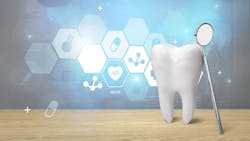Add value for patients with integrated treatment, xylitol, and education
The economic turbulence has not left dentists unscathed. Rising costs due to inflation, staffing shortages, and lower insurance reimbursements are just some of the challenges practices have faced lately. It’s no wonder that dental professionals are looking for ways to increase office profitability.
While there’s no one-size-fits-all solution for dental practices to weather financial storms, one thing is certain; retaining patients and attracting new ones are essential. A focus on providing quality care and building strong relationships with patients through added value is a smart way to recession-proof your practice.
Here I’ll explore adding value for your patients through integrative care, the use of xylitol to reduce oral disease, and through education to help people properly manage their oral health.
Treat the whole patient
Dental patients often arrive at our offices with an extensive history, both medical and personal. This can make it difficult to sort out the root causes of certain conditions, such as caries and periodontal disease. Often, dental professionals want to treat the surface symptoms through dental restorations, periodontal scaling and root planing, and then send patients out the door marked “completed.”
To add value, practitioners can spend a little time getting to the bottom of what’s causing a problem (root cause) so that it doesn’t recur. Integrative care—looking at health problems as they relate to one another instead of addressing only a single issue at a time—can help dental patients not only improve their well-being but feel seen and valued as a complex individual. This is personalized care.1
For example, pediatric patients with severe dental caries may have any number of underlying nutritional and social factors contributing to their condition. Diet, mouth breathing, lifestyle, oral dysbiosis, anxiety, or interactions with certain medications, such as many of those prescribed for ADHD, are common culprits.2-4
Other integrative care examples might be nutritional counseling, teaching stress management, or a gamified approach to helping patients meet health goals that can impact their oral health.5 Treatments that consider all aspects of a patient’s life are more likely to be successful long-term. Looking at the patient as a whole, as an individual, is patient-centric. Being patient-centric means you also educate patients about what they need to do, and you give them the tools to help them succeed. Then their health care becomes their responsibility.
You might also be interested in: Patient education could be the key to recall and retention
Prescribe xylitol to improve outcomes
Patients often turn to innovative treatments and dental professionals to guide them on what works. One popular ingredient finding renewed use in toothpaste, gum, and even skin-care products is xylitol.6-7
Xylitol has many dental benefits, including helping prevent dental decay, reduced plaque, and added saliva production.8 Additionally, xylitol is highly effective at reducing the harmful bacteria Porphyromonas gingivalis (Pg).9 Pg, which contributes to periodontitis, atherosclerosis, inflammatory Alzheimer’s, insulin resistance, preeclampsia, and other systemic illnesses, is considered a keystone pathogen.10 Pg is an intracellular bacterial pathogen (IBP), and it attaches to epithelial cells and invades the cells.11
Once intracellular, it multiplies in phagolysosomes, epigenetically influencing the epithelial tight junctions, and the cell becomes senescent, allowing the IBP to flourish yet remain elusive to the host’s immune system. Pg is a systemic pathogen found in many human cells, even neural cells.12 Once inside the host’s macrophages, Pg increases the nitric oxide production, creating capillary dilation and growth, which brings nutrients to the infected cells and allows body-wide dissemination of the pathogen.13
Brushing, flossing, or a professional cleaning alone cannot completely remove Pg, so it will persist, invade, and cause more harm to the infected patient.14 Xylitol is a prebiotic that prevents the adhesion and invasion of Pg and keeps it from oral propagating or entering the bloodstream and causing systemic disease.15
Because xylitol is a natural alternative to sugar, it tastes good (while not contributing to decay), making it an ideal remedy for pediatric patients or other difficult-to-treat populations.16 Formulated in chewing gum, xylitol can be offered frequently and successfully. Chewed three times a day, xylitol gum has been proven to significantly reduce the number of dental caries in patients, with few side effects.17 There are also xylitol mints, candies, toothpastes, mouth rinses, and sprays that are easy to implement in daily preventive care.
Create a positive experience
When dentists spend the necessary time to educate patients about the relationship between oral hygiene and other health factors, they give the best value of all. Many people don’t realize that dental diseases are interconnected with other conditions, including acne, anxiety, poor gut health, heart disease, cancer, and even dementia, among many others. Preventing infection is the first step, but for all patients, it’s imperative to check on social determinants of health, offer solutions without judgment, and give people a solid understanding of how they can take care of themselves and reduce their risk of serious illnesses.
More than the specific clinical aspects of a visit, patients often remember how they felt when they left the practice. The extra few minutes dental team members spend providing a solid educational foundation can be the difference between someone who truly understands and protects their health and someone who is frustrated and overwhelmed.18 Patients who feel heard and see improvements in their lives are those who will recommend your practice.
In summary
Dentists must consider economic conditions when interacting with their patients. When there’s a recession, people tend to cut back on expenses they view as nonessential. Unfortunately, dental care may fall into that category. However, prevention is cheap, and patients deserve the chance to take charge of their health.
Dental practices that add value for their patients through education will likely have more consistent patient visits, even during uncertain financial times.18 Offering additional services, such as integrative care, xylitol treatments, and patient education, gives dental professionals the opportunity to build strong relationships with their patients and maintain a practice that is financially stable and that provides the best possible outcomes for oral health.
Editor's note: This article appeared in the August 2023 print edition of Dental Economics magazine. Dentists in North America are eligible for a complimentary print subscription. Sign up here.
References
- Sanders KA, Zerden LS, Zomorodi M, Ciarrocca K, Schmitz KL. Promoting whole health in the dental setting: steps toward an integrated interprofessional clinical learning environment involving pharmacy, social work, and nursing. Int J Integr Care. 2021;21(4):20. doi:10.5334/ijic.5814
- Peres MA, Sheiham A, Liu P, et al. Sugar consumption and changes in dental caries from childhood to adolescence. J Dent Res. 2016;95(4):388-394. doi:10.1177/0022034515625907
- Rosenberg SS, Kumar S, Williams NJ. Attention deficit/hyperactivity disorder medication and dental caries in children. J Dent Hyg. 2014;88(6):342-347. https://jdh.adha.org/content/88/6/342
- Alqutami J, Elger W, Grafe N, Hiemisch A, Kiess W, Hirsch C. Dental health, halitosis and mouth breathing in 10-to-15 year old children: a potential connection. Euro J Paedi Dent. 2019;20(4):274-279. doi:10.23804/ejpd.2019.20.04.03
- Grigalauskienė R, Slabšinskienė E, Vasiliauskienė I. Biological approach of dental caries management. Stomatologija. 2015;17(4):107-112.
- Nayak PA, Nayak UA, Khandelwal V. The effect of xylitol on dental caries and oral flora. Clin Cosme Investigat Dent. 2014;6(11):89-94. doi:10.2147/CCIDE.S55761
- Salli K, Lehtinen MJ, Tiihonen K, Ouwehand AC. Xylitol's health benefits beyond dental health: a comprehensive review. Nutrients. 2019;11(8):1813. doi:10.3390/nu11081813
- Janakiram C, Deepan Kumar CV, Joseph J. Xylitol in preventing dental caries: A systematic review and meta-analyses. J Nat Sci Biol Med. 2017;8(1):16-21. doi:10.4103/0976-9668.198344
- Han SJ, Jeong SY, Nam YJ, Yang KH, Lim HS, Chung J. Xylitol inhibits inflammatory cytokine expression induced by lipopolysaccharide from Porphyromonas gingivalis. Clin Diag Lab Immun. 2005;12(11):1285-1291. doi:10.1128/CDLI.12.11.1285-1291.2005
- Olsen I, Taubman MA, Singhrao SK. Porphyromonas gingivalis suppresses adaptive immunity in periodontitis, atherosclerosis, and Alzheimer's disease. J Oral Microb. 2016;8(11):33029. doi:10.3402/jom.v8.33029
- Mu W, Jia Y, Chen X, Li H, Wang Z, Cheng B. Intracellular Porphyromonas gingivalis promotes the proliferation of colorectal cancer cells via the MAPK/ERK signaling pathway. Front Cell Inf Micro. 2020;10(12):584798. doi:10.3389/fcimb.2020.584798
- Nonaka S, Kadowaki T, Nakanishi H. Secreted gingipains from Porphyromonas gingivalis increase permeability in human cerebral microvascular endothelial cells through intracellular degradation of tight junction proteins. Neurochem Int. 2022;154(3):105282. doi:10.1016/j.neuint.2022.105282
- Pudla M, Srisatjaluk R, Utaisincharoen P. Induction of inducible nitric oxide synthase (iNOS) in Porphyromonas gingivalis LPS-treated mouse macrophage cell line (RAW264.7) requires toll-like receptor 9. Inflam Res. 2018;67(9):723-726. doi:10.1007/s00011-018-1168-1
- Hajishengallis G. Porphyromonas gingivalis-host interactions: open war or intelligent guerilla tactics? Microbes Inf. 2009;11(6-7):637-645. doi:10.1016/j.micinf.2009.03.009
- Park E, Na HS, Kim SM, Wallet S, Cha S, Chung J. Xylitol, an anticaries agent, exhibits potent inhibition of inflammatory responses in human THP-1-derived macrophages infected with Porphyromonas gingivalis. J Perio. 2014;85(6):e212–e223. doi:10.1902/jop.2014.130455
- Molina G, Zar M, Dougall A, McGrath C. Management of dental caries lesions in patients with disabilities: update of a systematic review. Front Oral Health. 2022;3(11):980048. doi:10.3389/froh.2022.980048
- Söderling E, Pienihäkkinen K. Effects of xylitol chewing gum and candies on the accumulation of dental plaque: a systematic review. Clin Oral Invest. 2022;26(1):119-129. doi:10.1007/s00784-021-04225-8
- Scambler S, Asimakopoulou KA. Model of patient-centred care–turning good care into patient-centred care. Br Dent J. 2014;217(10):225-228. doi:10.1038/sj.bdj.2014.755
About the Author

Mark L. Cannon, DDS, MS
Mark L. Cannon, DDS, MS, is a professor of otolaryngology, Division of Dentistry at Northwestern University, Feinberg School of Medicine, an attending physician at Ann and Robert Lurie Children’s Hospital, and a member of the International Association of Pediatric Dentistry. He’s the founder of Associated Dental Specialists of Long Grove, the research coordinator of the pediatric dental residency program at Ann and Robert Lurie Children’s Hospital, and the current president of the American Academy for Oral & Systemic Health.
